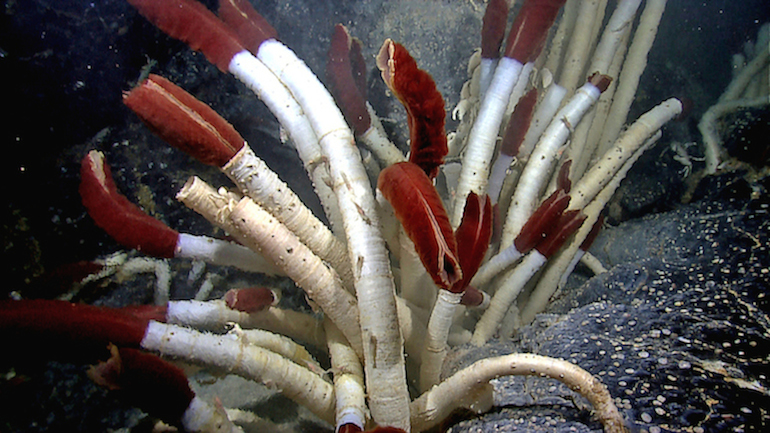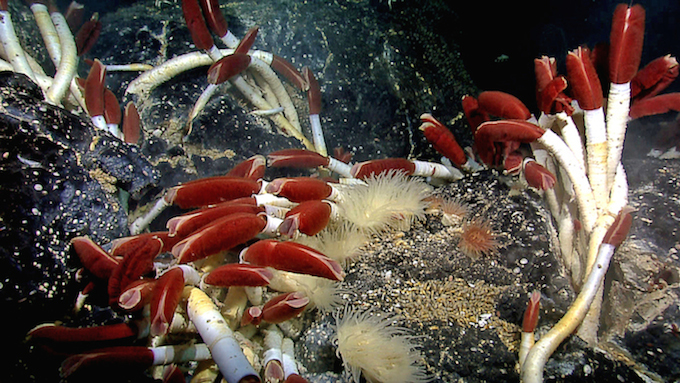The organisms above are Riftia tubeworms, which live in the deep sea near hydrothermal vents in the ocean floor. They are the best examples I know of something discussed, cautiously, in Philosophy of Biology, chapter 5, and they are good enough examples for me to agree with some arguments I’d formerly been uncertain about.
There’s a lot of literature now, in both biology and philosophy of biology, on “individuals,” and the nature of individuality. I argue in the book (and also here) that there’s good reason to split the intuitive biological concept of an individual into two. There are organisms and Darwinian individuals. The former is mostly a metabolic category: organisms keep themselves alive, maintaining their structure and activity in the face of thermodynamic tendencies toward decay. Darwinian individuals are things that reproduce, where “reproduction” is understood in a way that is relevant to evolutionary theory. Where there is reproduction, in this sense, there must be parent-offspring lineages.
Some things are Darwinian individuals without being organisms: viruses are a good example. Are there any organisms that are not Darwinian individuals? The important possible cases are symbiotic associations between animals and microbes, where the microbial partners are acquired from the environment rather than being transmitted from the animal’s parents. A standard example is the squid-vibrio symbiosis, an association between the Hawiian bobtail squid and bacteria which function as a “light organ” inside the squid, enabling camouflage. These objects would be organisms, in virtue of their metabolic integration, but not Darwinian individuals, as they don’t reproduce as a unit (more on this last point here). Some people think that we are in this category – multi-lineage organisms – given the way our gut bacteria are integrated into our metabolism.*
I’ve always been uncertain about these ideas, partly because in the cases that have been offered as examples, the integration of the symbiotic partners does not seem that tight. I’ve wondered whether some claims made about multi-lineage organisms depend on slightly overstating the degree of integration and dependence between the partners. While writing a new paper about this, I asked Maureen O’Malley to tell me her best case – a case where an environmentally acquired symbiont is very tightly integrated into the metabolism of an animal. Her reply was the case above: vestimentiferan tubeworms. These are annelids, like ordinary earthworms. When they are juvenile they have an ordinary annelid sort of form, including a gut. They then acquire a set of symbiotic bacteria from their environment, which they depend on for their energy supply, and during a metamorphosis step the worms lose their functioning digestive tract altogether. The bacteria seem to be taken up from the sea round them, not from one of the worm’s parents, and also are found free-living.
This case is convincing. Once an animal gives up its digestive tract entirely, replacing it with a colony of symbiotic bacteria, I think we do indeed have a “multi-lineage” organism, and an organism that is not a Darwinian individual in its own right. Instead, these organisms are formed repeatedly through the actions of several Darwinian individuals that collaborate and coevolve but do not combine into a single reproducing object.
______________________
Notes:
* “Some people think that we are in this category…” Thomas Pradeu has several good papers, and a book, that make this case.
Dupré and O’Malley did mention the deep sea tube worm example in an earlier paper, but for some reason I’d not noticed the strength of this example then.
The aphid-Buchnera symbiosis is not an example of what I’m discussing here, because each aphid’s symbiotic bacteria are acquired from the mother. The different reproductive lineages have fused into one. Lichen are a mixed case, with features of each the cases discussed here, and more. I need to have a closer look at them.
Austin Booth has discussed, in more detail, the relations between organisms and Darwinian individuals, as two fundamentally different sorts of “biological individual.”
The photos were taken by the NOAA Okeanos Explorer Program, Galapagos-Rift Expedition 2011. Public domain.

